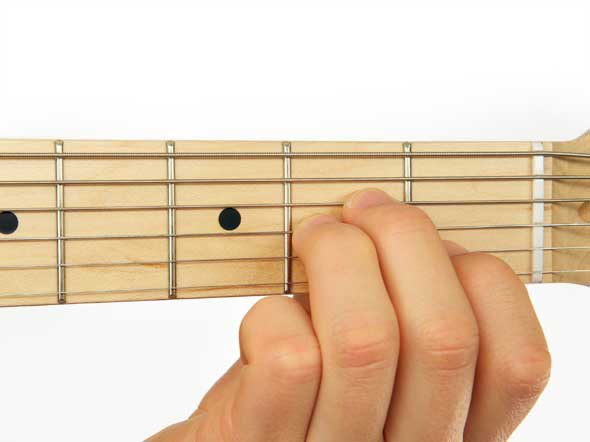
Minor Chord
There are three main types of chords: Major, Seventh, and Minor. The chord symbol for the minor chord is a small "m" placed after the letter name. Here are some commonly used open minor chord shapes.
A Minor Chord

Am

To play the Am chord, use the first, second and third fingers of your left hand as shown in the diagram. Strum all six strings.
Rhythm Pattern

In the following progression use pivot fingers on the second and fourth strings when changing between C and Am. Finish with one strum of the C chord.

D Minor Chord


To play the Dm chord, use the first, second and third fingers of your left hand as shown in the diagram. Strum only five strings.
Rhythm Pattern


E Minor Chord

Em

To play the Em chord, use the second and third fingers of your left hand as shown in the diagram. Strum all six strings. The Em chord shape is just the E chord shape with the first finger lifted off.
Rhythm Pattern

The Em is introduced in the following example. Finish on an Em chord.


Rhythm Pattern

The following example uses the minor chord to create a Country ballad sound. This progression should be played slowly. Finish on a G chord.





B Minor Chord

Bm

To play the Bm chord, use the first, second, third and fourth fingers of your left hand as shown in the diagram. Strum only four strings.
The following progression is in the key of G and contains the Bm chord.
Rhythm Pattern


The Three Four Time Signature


This time signature is called the three four time signature. It indicates there are three beats in each bar. Three four time is also known as waltz time. There are three quarter notes in one bar of ^ time.
The following chord progression is written in ^ time. To help keep time, accent (play louder) the first strum in each bar. Use your first and second fingers as pivots when changing between C and Am. Use your first finger as a pivot when changing between Dm and G7.
Rhythm Pattern



Three Four Time Rhythm Patterns
Practice the following ^ time rhythm patterns holding a C chord shape. Apply any of these patterns to the previous chord progression.






The following chord progression is in ^ time and uses the three minor chords introduced. Use your first finger as a pivot when changing between Dm and G7. Use your second finger as a pivot when changing between G7 and Em.
Rhythm Pattern

Rhythm Pattern



The next example is a 16 bar Country progression in ^ time.
Rhythm Pattern




